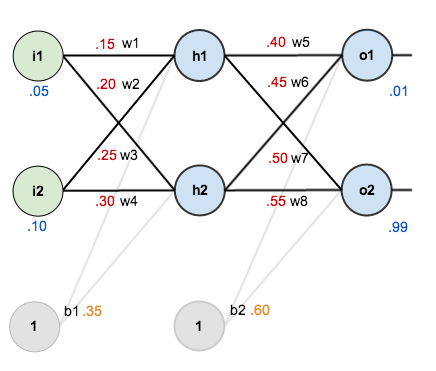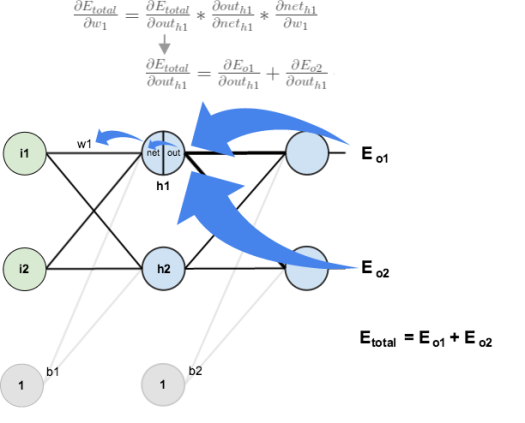BP算法演示
本文转载自https://mattmazur.com/2015/03/17/a-step-by-step-backpropagation-example/
Background
Backpropagation is a common method for training a neural network. There is no shortage of papers online that attempt to explain how backpropagation works, but few that include an example with actual numbers. This post is my attempt to explain how it works with a concrete example that folks can compare their own calculations to in order to ensure they understand backpropagation correctly.
If this kind of thing interests you, you should sign up for my newsletter where I post about AI-related projects that I’m working on.
Backpropagation in Python
You can play around with a Python script that I wrote that implements the backpropagation algorithm in this Github repo.
Backpropagation Visualization
For an interactive visualization showing a neural network as it learns, check out my Neural Network visualization.
Additional Resources
If you find this tutorial useful and want to continue learning about neural networks and their applications, I highly recommend checking out Adrian Rosebrock’s excellent tutorial on Getting Started with Deep Learning and Python.
Overview
For this tutorial, we’re going to use a neural network with two inputs, two hidden neurons, two output neurons. Additionally, the hidden and output neurons will include a bias.
Here’s the basic structure:

In order to have some numbers to work with, here are the initial weights, the biases, and training inputs/outputs:

The goal of backpropagation is to optimize the weights so that the neural network can learn how to correctly map arbitrary inputs to outputs.
For the rest of this tutorial we’re going to work with a single training set: given inputs 0.05 and 0.10, we want the neural network to output 0.01 and 0.99.
The Forward Pass
To begin, lets see what the neural network currently predicts given the weights and biases above and inputs of 0.05 and 0.10. To do this we’ll feed those inputs forward though the network.
We figure out the total net input to each hidden layer neuron, squash the total net input using an activation function (here we use the logistic function), then repeat the process with the output layer neurons.
Here’s how we calculate the total net input for :
We then squash it using the logistic function to get the output of :
Carrying out the same process for we get:
We repeat this process for the output layer neurons, using the output from the hidden layer neurons as inputs.
Here’s the output for :
And carrying out the same process for we get:
Calculating the Total Error
We can now calculate the error for each output neuron using the squared error function and sum them to get the total error:
For example, the target output for is 0.01 but the neural network output 0.75136507, therefore its error is:
Repeating this process for (remembering that the target is 0.99) we get:
The total error for the neural network is the sum of these errors:
The Backwards Pass
Our goal with backpropagation is to update each of the weights in the network so that they cause the actual output to be closer the target output, thereby minimizing the error for each output neuron and the network as a whole.
Output Layer
Consider . We want to know how much a change in
affects the total error, aka
.
By applying the chain rule we know that:
Visually, here’s what we’re doing:

We need to figure out each piece in this equation.
First, how much does the total error change with respect to the output?
Next, how much does the output of change with respect to its total net input?
The partial derivative of the logistic function is the output multiplied by 1 minus the output:
Finally, how much does the total net input of change with respect to
?
Putting it all together:
You’ll often see this calculation combined in the form of the delta rule:
Alternatively, we have and
which can be written as
, aka
(the Greek letter delta) aka the node delta. We can use this to rewrite the calculation above:
Therefore:
Some sources extract the negative sign from so it would be written as:
/*每个权重的梯度都等于与其相连的前一层节点的输出(即)乘以与其相连的后一层的反向传播的输出(即
,而
)*/
To decrease the error, we then subtract this value from the current weight (optionally multiplied by some learning rate, eta, which we’ll set to 0.5):
We can repeat this process to get the new weights ,
, and
:
We perform the actual updates in the neural network after we have the new weights leading into the hidden layer neurons (ie, we use the original weights, not the updated weights, when we continue the backpropagation algorithm below).
Hidden Layer
Next, we’ll continue the backwards pass by calculating new values for ,
,
, and
.
Big picture, here’s what we need to figure out:
Visually:

We’re going to use a similar process as we did for the output layer, but slightly different to account for the fact that the output of each hidden layer neuron contributes to the output (and therefore error) of multiple output neurons. We know that affects both
and
therefore the
needs to take into consideration its effect on the both output neurons:
Starting with :
We can calculate using values we calculated earlier:
And is equal to
:
Plugging them in:
Following the same process for , we get:
Therefore:
Now that we have , we need to figure out
and then
for each weight:
We calculate the partial derivative of the total net input to with respect to
the same as we did for the output neuron:
Putting it all together:
You might also see this written as:
/*每个权重的梯度都等于与其相连的前一层节点的输出(即i1)乘以与其相连的后一层的反向传播的输出(即δh1,一层层求出δh1是关键)*/
We can now update :
Repeating this for ,
, and
Finally, we’ve updated all of our weights! When we fed forward the 0.05 and 0.1 inputs originally, the error on the network was 0.298371109. After this first round of backpropagation, the total error is now down to 0.291027924. It might not seem like much, but after repeating this process 10,000 times, for example, the error plummets to 0.000035085. At this point, when we feed forward 0.05 and 0.1, the two outputs neurons generate 0.015912196 (vs 0.01 target) and 0.984065734 (vs 0.99 target).
总结:
1、每个权重的梯度都等于与其相连的前一层节点的输出 乘以 与其相连的后一层的反向传播的输出,重要的结论说三遍!
2、新权重 = 原权重 - *(总偏差对该权重的梯度值),如
3、参考博文:http://blog.csdn.net/zhongkejingwang/article/details/44514073
BP算法演示的更多相关文章
- 一文彻底搞懂BP算法:原理推导+数据演示+项目实战(上篇)
欢迎大家关注我们的网站和系列教程:http://www.tensorflownews.com/,学习更多的机器学习.深度学习的知识! 反向传播算法(Backpropagation Algorithm, ...
- 深度学习——前向传播算法和反向传播算法(BP算法)及其推导
1 BP算法的推导 图1 一个简单的三层神经网络 图1所示是一个简单的三层(两个隐藏层,一个输出层)神经网络结构,假设我们使用这个神经网络来解决二分类问题,我们给这个网络一个输入样本,通过前向运算得到 ...
- [DL学习笔记]从人工神经网络到卷积神经网络_1_神经网络和BP算法
前言:这只是我的一个学习笔记,里边肯定有不少错误,还希望有大神能帮帮找找,由于是从小白的视角来看问题的,所以对于初学者或多或少会有点帮助吧. 1:人工全连接神经网络和BP算法 <1>:人工 ...
- Backpropagation反向传播算法(BP算法)
1.Summary: Apply the chain rule to compute the gradient of the loss function with respect to the inp ...
- JS写的排序算法演示
看到网上有老外写的,就拿起自已之前完成的jmgraph画图组件也写了一个.想了解jmgraph的请移步:https://github.com/jiamao/jmgraph 当前演示请查看:http:/ ...
- stanford coursera 机器学习编程作业 exercise4--使用BP算法训练神经网络以识别阿拉伯数字(0-9)
在这篇文章中,会实现一个BP(backpropagation)算法,并将之应用到手写的阿拉伯数字(0-9)的自动识别上. 训练数据集(training set)如下:一共有5000个训练实例(trai ...
- (转)神经网络和深度学习简史(第一部分):从感知机到BP算法
深度|神经网络和深度学习简史(第一部分):从感知机到BP算法 2016-01-23 机器之心 来自Andrey Kurenkov 作者:Andrey Kurenkov 机器之心编译出品 参与:chen ...
- 多层感知机及其BP算法(Multi-Layer Perception)
Deep Learning 近年来在各个领域都取得了 state-of-the-art 的效果,对于原始未加工且单独不可解释的特征尤为有效,传统的方法依赖手工选取特征,而 Neural Network ...
- 关于BP算法在DNN中本质问题的几点随笔 [原创 by 白明] 微信号matthew-bai
随着deep learning的火爆,神经网络(NN)被大家广泛研究使用.但是大部分RD对BP在NN中本质不甚清楚,对于为什这么使用以及国外大牛们是什么原因会想到用dropout/sigmoid ...
随机推荐
- Cocos2d-X网络编程(3) Cocos2d中的网络通信协议——WebSocket协议
WebSocket protocol 是HTML5一种新的协议.它实现了浏览器与服务器全双工通信.实现浏览器与服务器的即时通讯.即服务器也能主动向客户端发消息. WebSocket代理类和方法: co ...
- 【linux开发】apt源设置
不同的网络状况连接以下源的速度不同, 建议在添加前手动验证以下源的连接速度(ping下就行),选择最快的源可以节省大批下载时间. 首先备份源列表: sudo cp /etc/apt/sources.l ...
- react-native的技巧
按钮定制 給图片添加点击事件 <TouchableOpacity onPress={this.lookAlbum} style={{flex: 0, height: 40, width: 40, ...
- Bubble Sort(冒泡排序)
冒泡排序(英语:Bubble Sort,台湾另外一种译名为:泡沫排序)是一种简单的排序算法.它重复地走访过要排序的数列,一次比较两个元素,如果他们的顺序错误就把他们交换过来.走访数列的工作是重复地进行 ...
- Dos - 学习总结(1)
1.控制台复制 1>鼠标右键,标记. 2>选定复制内容后,鼠标右键,完成复制. 2.
- 洛谷P2507 [SCOI2008]配对 题解(dp+贪心)
洛谷P2507 [SCOI2008]配对 题解(dp+贪心) 标签:题解 阅读体验:https://zybuluo.com/Junlier/note/1299251 链接题目地址:洛谷P2507 [S ...
- activemq高可用
这里是基于 zookeeper 选举方式实现的集群配置,服务器过半数才可提供服务,所以是2n+1台这里以三台为例. 只有master节点能提供服务,slave节点无法提供服务,只有当master节点挂 ...
- 原生js格式化json和格式化xml的方法
在工作中一直看各位前辈的博客解决各种问题,对我的帮助很大,非常感谢! 之前一直比较忙没有写博客,终于过年有了点空闲时间,可以把自己积累的东西分享下,笔记中的部分函数不是自己写的,都是工作中一点点积累的 ...
- 39. Combination Sum (Java)
Given a set of candidate numbers (candidates) (without duplicates) and a target number (target), fin ...
- layoutSubviews何时调用的问题(原文:http://www.cnblogs.com/pengyingh/articles/2417211.html)
今天跟旺才兄学习了一下UIView的setNeedsDisplay和setNeedsLayout方法.首先两个方法都是异步执行的.而setNeedsDisplay会调用自动调用drawRect方法,这 ...
